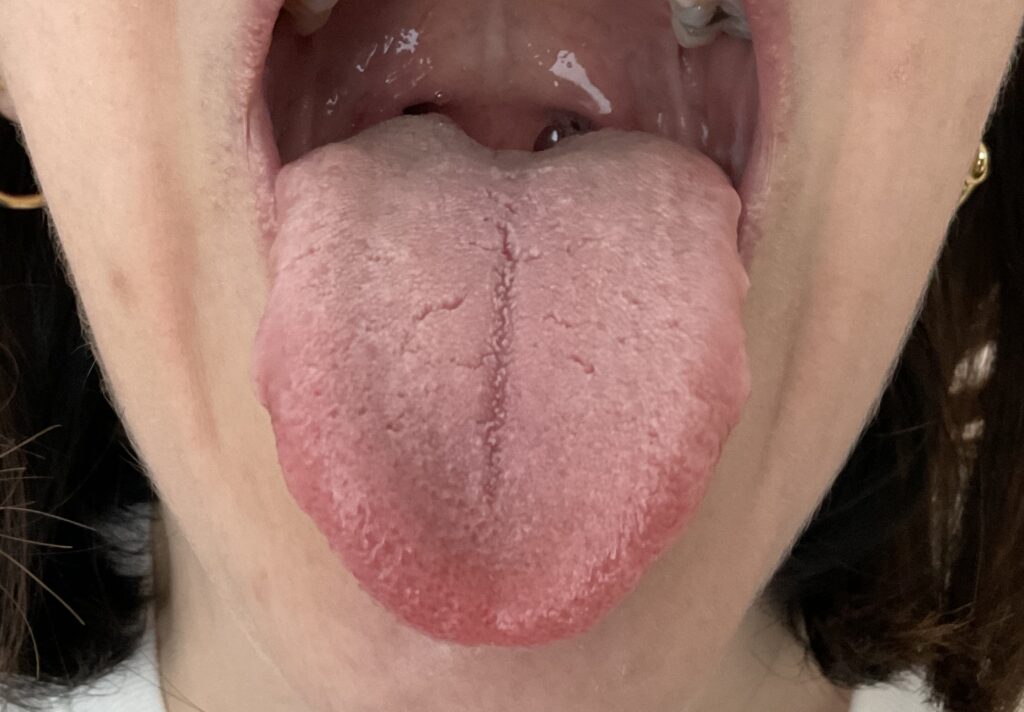In Chinese medicine, the tongue is more than just a muscle—it’s a powerful diagnostic tool that reflects the state of your internal organs, blood flow, and the presence of pathogenic factors. At Aetherium, patients are familiar with tongue diagnosis as a key part of their treatment. Alongside the intake and pulse diagnosis, the tongue provides objective insights that help practitioners create personalized treatment plans.
The tongue’s appearance is a dynamic gauge of health, offering clues about the progression and sometimes improvement of a patient’s condition. By carefully analyzing the tongue’s color, shape, coating, and moisture, practitioners can identify patterns of disharmony and tailor treatments accordingly. This is especially valuable in complex cases, such as chronic conditions or long-term medication use.

The Tongue as a Diagnostic Tool
In Chinese medicine, the tongue is examined systematically, with attention to specific aspects that reveal underlying imbalances. Here’s what practitioners look for:
1. Vitality of the Tongue
The “spirit” of the tongue reflects overall vitality. A tongue with a vibrant, lively appearance suggests a good prognosis, even if other symptoms are present. Conversely, a dark, withered tongue indicates a more serious condition and a poorer prognosis.
2. Tongue Color
The color of the tongue body (beneath the coating) provides insights into the state of the blood, yin organs, and qi. For example:
- A purple tongue suggests blood stagnation.
- A very pale tongue may indicate blood or yang deficiency.
- A dark red tongue points to intense heat in one or more organs.
3. Tongue Shape
The shape of the tongue—whether thin, swollen, long, or short—helps identify excess or deficient patterns. For instance:
- A swollen tongue often indicates dampness or phlegm caused by pathogenic fluid accumulation.
- Pinched sides suggest stagnation.
- Cracks on the tongue, resembling dry soil, signal severe depletion of body fluids.
4. Tongue Coating
The coating reflects the state of the internal organs and the presence of pathogenic factors.
- A white coating corresponds to cold, while a yellow coating indicates heat.
- The thickness of the coating reflects the strength of pathogenic factors.
- The topography of the coating can reveal whether the disease is internal or external.
Pro tip: Never scrape off your tongue coating before a consultation—it holds valuable diagnostic information!
5. Tongue Moisture
The moisture level of the tongue indicates the status of the body’s fluids. A healthy tongue should be slightly moist—neither too dry nor too wet.
What Does a Healthy Tongue Look Like?
A healthy tongue is a reflection of balanced qi, blood, and fluids. Here’s what to look for:
- Spirit: The tongue should appear vibrant and lively, like that of a healthy child.
- Body Color: A pale red, “fresh” color indicates a healthy supply of blood and fluids.
- Shape: The tongue should be supple—neither too flabby nor too stiff—with no cracks, tremors, or ulcers.
- Coating: A thin, white coating reflects normal digestive function and a healthy gut biofilm.
- Moisture: The tongue should be slightly moist, indicating proper fluid balance.
Fat Tongues: A Modern Phenomenon
In today’s society, thin tongues are rare. Modern diets and lifestyles have led to an increase in swollen, “fat” tongues or wide tongues. While a quick Google search might attribute this to spleen qi deficiency, the underlying issue is often water retention caused by insufficient nitric oxide and ATP production. In Chinese medicine this may be known as dampness or phlegm.
Over time, this fluid accumulation can lead to systemic issues, making it crucial to address the root cause before attempting to nourish the body. Otherwise, you risk feeding pathogenic bacteria and worsening the condition. This is why patients on tonic substances, adaptogenic supplements or improper supplementation, don’t get better. At times can sometimes do more harm than good.
How Medications Affect the Tongue
Medications can significantly alter the tongue’s appearance, providing further diagnostic clues:
- Antibiotics: Often cause the tongue coating to peel in patches, reflecting injury to stomach yin.
- Corticosteroids: Oral steroids can make the tongue red and swollen after about a month of use.
- Bronchodilators: Prolonged use may cause the tongue tip to become red.
- Diuretics: Long-term use can lead to yin deficiency, drying out the tongue.
- Anti-inflammatory Drugs: Certain medications can thicken or darken the tongue coating.
- Antineoplastics: Cytotoxic drugs used in cancer treatment often cause a thick, brown, or black coating.
Why Tongue Diagnosis Matters
The tongue is a mirror of the body’s internal state, offering a wealth of information about organ function, fluid balance, and overall health. By understanding its nuances, practitioners can pinpoint areas of imbalance and provide targeted support.
At Aetherium, tongue diagnosis is an essential part of our holistic approach to health. Whether you’re dealing with a chronic condition or simply seeking to optimize your well-being, your tongue can tell a story—and we’re here to listen.
References
Maciocia, G. (1995). Tongue diagnosis in Chinese medicine. Churchill Livingstone.
Kaptchuk, T. J. (1983). The web that has no weaver. Congdon & Weed.
Zhang, B., Wang, X., & Li, J. (2023). Tongue diagnosis in traditional Chinese medicine: Potential diagnostic and therapeutic applications. ScienceDirect. https://www.sciencedirect.com/science/article/pii/S2405844023098237
Chen, H., & Xu, J. (2022). Clarifying the connection between tongue diagnosis and systemic health: A review of clinical evidence. PMC. https://www.ncbi.nlm.nih.gov/pmc/articles/PMC9008461



0 Comments